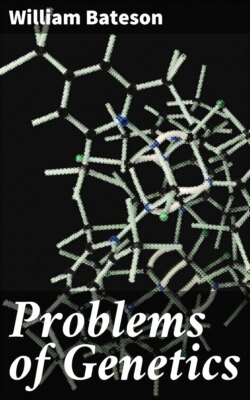Читать книгу Problems of Genetics - Bateson William - Страница 5
Introductory
ОглавлениеThe purpose of these lectures is to discuss some of the familiar phenomena of biology in the light of modern discoveries. In the last decade of the nineteenth century many of us perceived that if any serious advance was to be made with the group of problems generally spoken of as the Theory of Evolution, methods of investigation must be devised and applied of a kind more direct and more penetrating than those which after the general acceptance of the Darwinian views had been deemed adequate. Such methods obviously were to be found in a critical and exhaustive study of the facts of variation and heredity, upon which all conceptions of evolution are based. To construct a true synthetic theory of Evolution it was necessary that variation and heredity instead of being merely postulated as axioms should be minutely examined as phenomena. Such a study Darwin himself had indeed tentatively begun, but work of a more thorough and comprehensive quality was required. In the conventional view which the orthodoxy of the day prescribed, the terms variation and heredity stood for processes so vague and indefinite that no analytical investigation of them could be contemplated. So soon, however, as systematic inquiry into the natural facts was begun it was at once found that the accepted ideas of variation were unfounded. Variation was seen very frequently to be a definite and specific phenomenon, affecting different forms of life in different ways, but in all its diversity showing manifold and often obvious indications of regularity. This observation was not in its essence novel. Several examples of definite variation had been well known to Darwin and others, but many, especially Darwin himself in his later years, had nevertheless been disposed to depreciate the significance of such facts. They consequently then lapsed into general disparagement. Upon more careful inquiry the abundance of such phenomena proved to be far greater than was currently supposed, and a discussion of their nature brought into prominence a consideration of greater weight, namely that the differences by which these definite or discontinuous variations are constituted again and again approximate to and are comparable with the class of differences by which species are distinguished from each other.
The interest of such observations could no longer be denied. The more they were examined the more apparent it became that by means of the facts of variation a new light was obtained on the physiological composition and capabilities of living things. Genetics thus cease to be merely a method of investigating theories of evolution or of the origin of species but provide a novel and hitherto untried instrument by which the nature of the living organism may be explored. Just as in the study of non-living matter science began by regarding the external properties of weight, opacity, colour, hardness, mode of occurrence, etc., noting only such evidences of chemical attributes and powers as chance spontaneously revealed; and much later proceeded to the discovery that these casual manifestations of chemical properties, rightly interpreted, afford a key to the intrinsic nature of the diversity of matter, so in biology, having examined those features of living things which ordinary observations can perceive, we come at last to realize that when studied for their own sake the properties of living organisms in respect of heredity and variation are indications of their inner nature and provide evidences of that nature which can be obtained from no other source.
While such ideas were gradually forming in our minds, came the rediscovery of Mendel's work. Investigations which before had only been imagined as desirable now became easy to pursue, and questions as to the genetic inter-relations and compositions of varieties can now be definitely answered. Without prejudice to what the future may disclose whether by way of limitation or extension of Mendelian method, it can be declared with confidence and certainty that we have now the means of beginning an analysis of living organisms, and distinguishing many of the units or factors which essentially determine and cause the development of their several attributes.
Briefly put, the essence of Mendelism lies in the discovery of the existence of unit characters or factors. For an account of the Mendelian method, how it is applied and what it has already accomplished, reference must be made to other works.[1] With this part of the subject I shall assume a sufficient acquaintance. In these lectures I have rather set myself the task of considering how certain problems appear when viewed from the standpoint to which the application of these methods has led us. It is indeed somewhat premature to discuss such questions. The work of Mendelian analysis is progressing with great rapidity and anything I can say may very soon be superseded as out of date. Nevertheless a discussion of this kind may be of at least temporary service in directing inquiry to the points of special interest.
